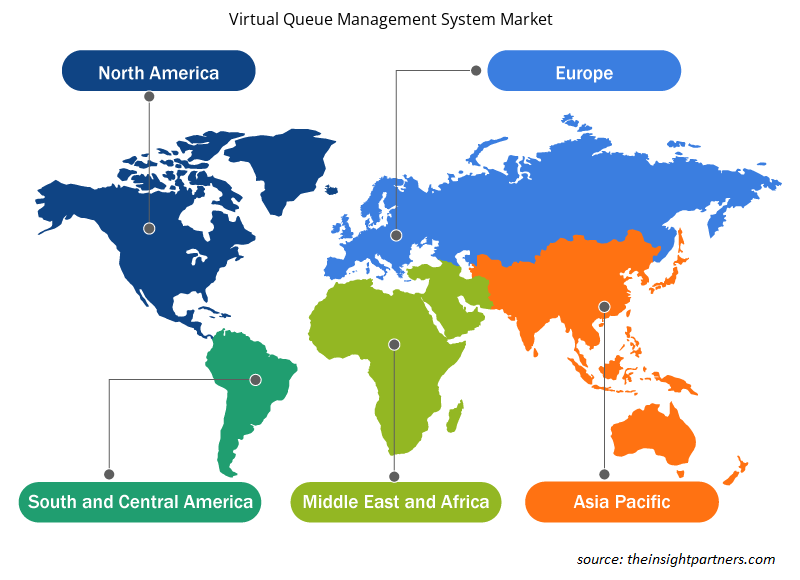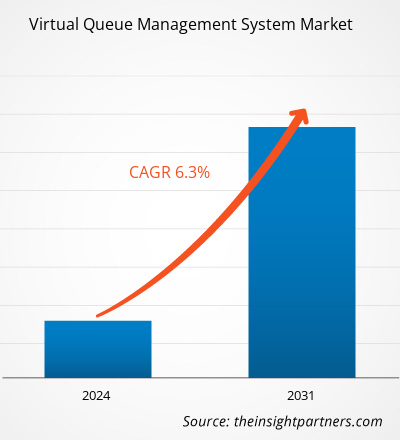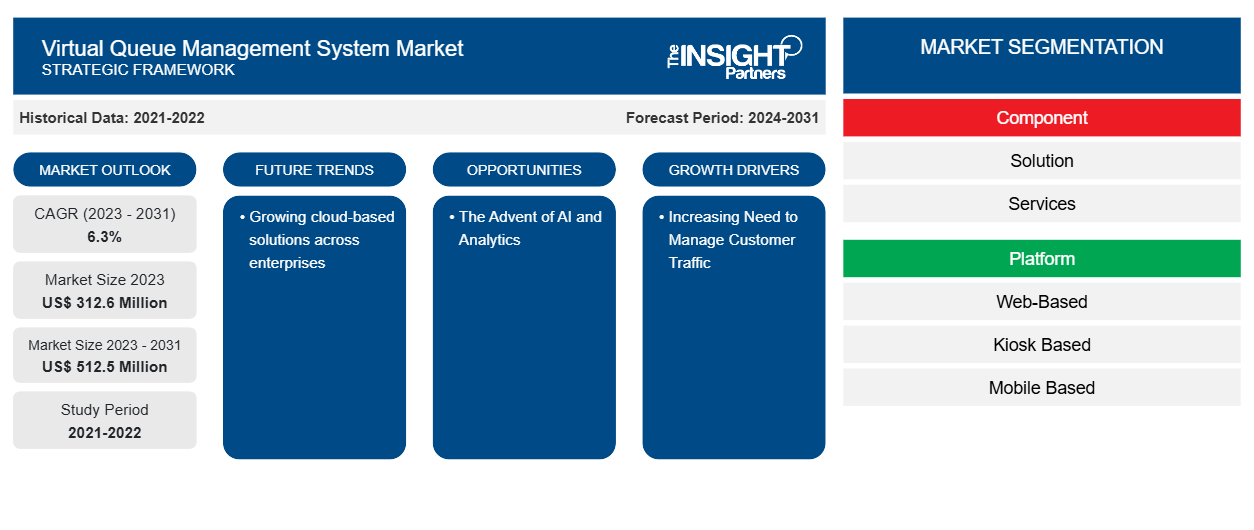虚拟排队管理系统市场规模预计将从 2023 年的 3.126 亿美元增至 2031 年的 5.125 亿美元。预计 2023-2031 年期间市场复合年增长率为 6.3%。企业间基于云的解决方案的增长可能仍是市场的主要趋势。
虚拟队列管理系统市场分析
虚拟排队管理可以提高客户满意度、简化沟通、增加客户流量并缩短等待时间。使用虚拟排队系统的公司还可以容纳更多客户。虚拟排队系统可以改善机场客流量管理。这有助于避免过度拥挤并确保在办理登机手续、安全检查和登机等活动之间更好地过渡。
虚拟队列管理系统市场概况
虚拟排队解决方案可最大限度地减少或消除物理队列,确保客户花更少的时间排队。虚拟队列提供实时更新,让客户了解自己的位置并增强他们的整体体验。虚拟队列管理解决方案可减少额外的人工成本并确保资源得到有效部署。虚拟队列管理系统还可以让您根据客户的服务需求智能地将客户引导到正确的队列,从而为您带来好处。如果客户错误地选择了错误的队列,可以快速为他们更改。
定制此报告以满足您的需求
您可以免费定制任何报告,包括本报告的部分内容、国家级分析、Excel 数据包,以及为初创企业和大学提供优惠和折扣
- 获取此报告的关键市场趋势。这个免费样品将包括数据分析,从市场趋势到估计和预测。
虚拟队列管理系统市场驱动因素和机遇
越来越需要管理客户流量以利于市场
监控消费者流量对企业的绩效至关重要。流量分析会跟踪客户的行为和习惯,同时也解释其含义。监控消费者流量有几个好处。在安全方面,跟踪客户活动并确定某个地点最常光顾的区域有助于防止某些区域被过度拥挤。此外,流量监控可以确保这些地点是安全的,并且不会有不法之徒进入。流量监控可用于各种业务,包括金融机构、零售店、医院、政府大楼、办公楼、校园、仓库等等。监控消费者流量还有助于确保购物体验或进入安全设施不会因排队过多而过度延迟。监控活动产生的数据使企业主能够牢牢掌握哪些区域最受欢迎,然后他们可以利用这些区域并做好适当的准备。因此,管理客户流量的需求不断增加,推动了市场的增长。
人工智能和分析的出现。
随着零售商越来越多地采用全渠道策略,人工智能队列管理技术在连接线上和线下互动方面发挥着重要作用。客户可以使用商店的应用程序查看实时队列长度,从而决定是否参加或预订一个位置以避免等待。这种无缝集成提高了消费者的幸福感和忠诚度。此外,人工智能还可用于估计消费者在队列中的等待时间。客户可以实时看到他们需要等待多长时间才能获得服务。这让客户可以计划行程并避免过多的排队,并可能决定在不那么繁忙的时候再来。如果在线提供这些信息,他们可以选择在等待时间最短的时候到达。这也将通过平滑需求和更好地利用资源使企业受益。人工智能可以帮助优先考虑等待的客户。这意味着有紧急需求的客户(例如需要在特定时间之前存入银行存款或行程迟到的客户)可能会先于那些需求不那么紧迫的客户得到服务。这有助于确保没有人遇到糟糕的结果而无法得到服务。
虚拟队列管理系统市场报告细分分析
有助于得出虚拟队列管理系统市场分析的关键部分是组件、平台和最终用户。
- 根据组件,虚拟队列管理系统市场分为解决方案和服务。
- 根据平台,市场分为基于网络的、基于信息亭的和基于移动的。
- 根据组织规模,市场分为中小型企业和大型企业。
- 就终端用户而言,市场分为零售、医院和诊所、机场、博物馆和图书馆等。
虚拟队列管理系统市场份额按地区分析
虚拟排队管理系统市场报告的地理范围主要分为五个区域:北美、亚太地区、欧洲、中东和非洲以及南美和中美。北美是一个技术先进的地区。该地区越来越多地采用各种数字解决方案。此外,IT 巨头的存在推动了市场的增长。虚拟排队程序从根本上改变了个人排队的方式,极大地提高了消费者体验。客户可以在任何地方用手机签到、查看等待时间并联系服务人员,而无需亲自参与,因此虚拟排队管理的采用正在增长。
虚拟队列管理系统市场区域洞察
Insight Partners 的分析师已详尽解释了预测期内影响虚拟队列管理系统市场的区域趋势和因素。本节还讨论了北美、欧洲、亚太地区、中东和非洲以及南美和中美洲的虚拟队列管理系统市场细分和地理位置。

- 获取虚拟队列管理系统市场的区域特定数据
虚拟队列管理系统市场报告范围
| 报告属性 | 细节 |
|---|---|
| 2023 年的市场规模 | 3.126亿美元 |
| 2031 年市场规模 | 5.125亿美元 |
| 全球复合年增长率(2023 - 2031) | 6.3% |
| 史料 | 2021-2022 |
| 预测期 | 2024-2031 |
| 涵盖的领域 | 按组件
|
| 覆盖地区和国家 | 北美
|
| 市场领导者和主要公司简介 |
|
虚拟队列管理系统市场参与者密度:了解其对业务动态的影响
虚拟排队管理系统市场正在快速增长,这得益于最终用户需求的不断增长,而这些需求又源于消费者偏好的不断变化、技术进步以及对产品优势的认识不断提高等因素。随着需求的增加,企业正在扩大其产品范围,进行创新以满足消费者的需求,并利用新兴趋势,从而进一步推动市场增长。
市场参与者密度是指在特定市场或行业内运营的企业或公司的分布情况。它表明在给定市场空间中,相对于其规模或总市场价值,有多少竞争对手(市场参与者)存在。
在虚拟队列管理系统市场运营的主要公司有:
- accesso 科技集团有限公司
- 研华有限公司
- AKIS 技术
- eGlobe IT 解决方案
- 拉维工业公司
- 翁博里
免责声明:上面列出的公司没有按照任何特定顺序排列。

- 获取虚拟队列管理系统市场顶级关键参与者概述
虚拟队列管理系统市场新闻和最新发展
虚拟排队管理系统市场通过收集一手和二手研究后的定性和定量数据进行评估,其中包括重要的公司出版物、协会数据和数据库。虚拟排队管理系统市场的一些发展如下所列:
- 虚拟队列管理和预约安排系统提供商 Lavi Industries 旗下的 Qtrac 今天宣布推出其 Qtrac NextGen 平台。Qtrac 队列管理系统的最新版本为企业提供了一个可扩展、安全且全面的改进型企业平台。它结合了强大的业务信息和数字营销技能,创造了新的收入来源,使公司能够改善客户体验,同时提高员工参与度和生产力。(来源:Qtrac,2021 年 11 月)
- Monta 推出电动汽车充电虚拟排队系统。新的“智能排队”功能允许驾驶员在一个或多个充电站加入虚拟排队,并在充电点可用时收到快速通知,以降低车辆在长途行驶时耗尽电量的可能性。(来源:Monta,2021 年 10 月)
虚拟队列管理系统市场报告范围和交付成果
“虚拟队列管理系统市场规模和预测(2021-2031)”报告对市场进行了详细分析,涵盖以下领域:
- 虚拟排队管理系统市场规模以及范围涵盖的所有关键细分市场的全球、区域和国家层面的预测
- 虚拟排队管理系统市场趋势以及市场动态,如驱动因素、限制因素和关键机会
- 详细的 PEST/波特五力分析和 SWOT 分析
- 虚拟排队管理系统市场分析涵盖主要市场趋势、全球和区域框架、主要参与者、法规和最新市场发展
- 行业格局和竞争分析,涵盖市场集中度、热图分析、知名参与者以及虚拟排队管理系统市场的最新发展
- 详细的公司简介
- 历史分析(2 年)、基准年、预测(7 年)及复合年增长率
- PEST和SWOT分析
- 市场规模、价值/数量 - 全球、区域、国家
- 行业和竞争格局
- Excel 数据集
近期报告
相关报告
客户评价
购买理由
- 明智的决策
- 了解市场动态
- 竞争分析
- 客户洞察
- 市场预测
- 风险规避
- 战略规划
- 投资论证
- 识别新兴市场
- 优化营销策略
- 提升运营效率
- 顺应监管趋势























 获取免费样品 - 虚拟队列管理系统市场
获取免费样品 - 虚拟队列管理系统市场